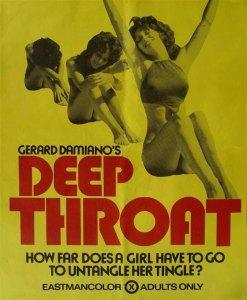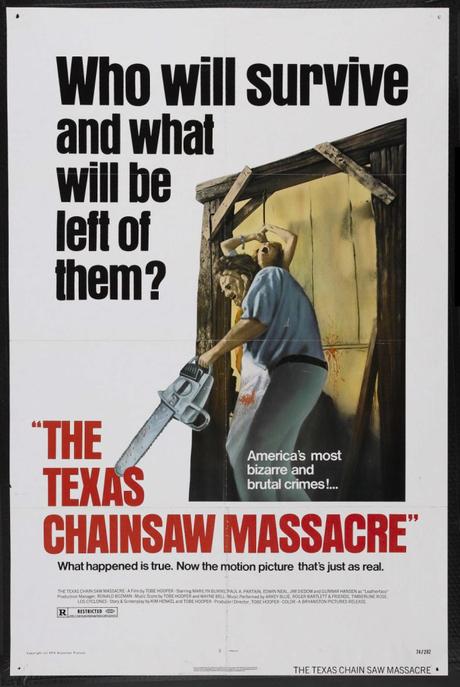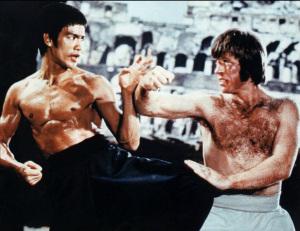When I first learned that The Wire‘s David Simon was creating a new HBO series called The Deuce about porn in New York’s Times Square in the 1970s I had this great idea for a new feature on this site: “Story Pitches For David Simon’s The Deuce.” Then I realized that such an on-going series of articles might be a bit too far outside the reach of what I usually write about here. So, I compressed it into a new list (“10 Little Known Stories from the Golden Age of Porn”) which I just got published over at WhatCulture.com. I’m not allowed to re-post the list here, but as a bit of an extended invitation for you to head over to WhatCulture I’ve expanded one item from that list: this is the story of how Deep Throat gave us The Texas Chainsaw Massacre.
You first have to first understand why exactly Deep Throat was so popular. Seth Grahame-Smith jokes in The Big Book of Porn, “According to film historians, the first motion picture was screened in December 1895. And the first dirty motion picture was screened just a few months later.” Indeed. Dirty movies are almost as old as film itself. From short clips of a woman undressing in the early days of film to the nudie cuties of the 1950s and 60s, when there were lots of movies about nudists and scenes of naked people playing volleyball, porn had always existed right on the periphery of legitimate film. However, the way that porn rose in New York in the 1960s into the 70s oddly mimics the early history of film itself, i.e., originally viewed in short segments via peep machines, evolving into longer-form via documentaries and then actual narrative storytelling, and setting up residence in actual theaters and making the kind of money that brought unwanted attention from the mob.

The FBI wanted to kill Deep Throat, partially for the sake of public decency, but also because the mob was the money behind it. The Peraino family, deeply connected to Colombo crime family, bankrolled Deep Throat’s sub-$50K budget, and they were strong-arming theaters into giving them an unfair cut of ticket sales, threatening physical violence and burning a theater or two down for non-compliance. So, it was appalling to the FBI to see Deep Throat selling out everywhere it played, grossing at least $100 million and perhaps as high as $600 million (more on that in a minute). The Feds tried to arrest anyone and everyone connected to Deep Throat, including its stars, charging them with obscenity. Linda Lovelace turned state’s evidence and testified against her co-star Harry Reems as did the film’s director Gerard Damiano. Hollywood personalities rallied to Reems defense, fearing that if the FBI succeeded in killing Deep Throat it would leverage that into charging overly violent or sexual Hollywood movies with obscenity, which, as it turns out, is exactly what some at the FBI wanted to do.
It’s only later on that Lovelace became the centerpiece of the feminist anti-porn movement, rolled out on various talkshows of the era to describe how she’d actually been forced to make Deep Throat by an abusive husband and coked out sleazeballs who would hear her complaints about not wanting to do something in the movie and then quietly put a gun on the table as an act of intimidation. Not surprisingly, pretty much every single other person connected to the movie remembers it differently.
Deep Throat remains one of the most successful independent films of all time, produced for a mere $47,500 and grossing either $600 million (according to the mob-connected producers) or $100 million (according to Bill Kelly at the FBI) or somewhere between $30 million and $50 million (according to a 2005 Los Angeles Times article). Either way, there was plenty of money coming in, and the producers weren’t sharing it with anyone, using scary mob tactics to buy Gerard Damiano out of his contractual right to a cut of the profits.
So, how does this relate to Texas Chain Saw Massacre?

Truthfully, he’s told different stories for where his inspiration came from, but the important part is that while the mob was counting its Deep Throat profits Hooper was working with Kim Henkel to write the screenplay for what became Texas Chain Saw Massacre (they originally called it Leatherface). They hustled and flowed their way into securing a $100,000 budget from various Texas financiers, such as legislators, attorneys and even a pot smuggler. It was Hooper’s second time directing a feature film, after an experimental hippie movie called Eggshells, and they filmed for around 32 days in the deep heat of July and August of 1973. The financiers figured they at least had a good Texas drive-in movie, although Hooper hoped to “build a fire big enough that it would get noticed all the way out in Hollywood.”
That fire was noticed by the wrong people, though. All of the major studios turned down the opportunity distribute Texas Chain Saw Massacre, with places like Warner Bros., Columbia and Universal wanting nothing to do with distributing a glorified snuff film. There was a new company, Bryanston Films, which had much lower standards. Violence didn’t bother them, nor did sex, for that matter. Why should it? Bryanston Films was run by the mob, with Louis “Butchie” Peraino as the CEO, and it had money to burn thanks to Deep Throat. Hooper and company got into bed with the devil.
However, if there was a cemetery somewhere in Hollywood for all of the production companies which were set up by people with money to burn only to get chewed up and spit out by the Hollywood machine Bryanston Fims would be on one of the headstones.
The Perainos had no real experience with the feature film business, and they couldn’t exactly announce themselves as the people who had made Deep Throat, a possibly illegal film other companies wouldn’t want to be associated with. They also couldn’t intimidate people. So, they substantially overpaid for everything, and everyone in Hollywood was more than happy to take their money and string them along without ever actually getting a single movie made. Bryanston hired all sorts of industry people and gobbled up at least 9 different scripts they intended to turn into movies. They bought the national distribution rights to at least twenty different mid-70s grindhouse flicks, such as Andy Warhol’s Frankenstein, Coonskin, Bruce Lee’s Return of the Dragon and, of course, Texas Chain Saw Massacre.

Maybe that’s because Al specifically met with Joe Peraino. When some of the investors behind Texas Chain Saw went to Bryanston to understand how they movie had made around $20 million and yet their royalty check was for no more than a few hundred dollars, they met with Louis Peraino who nonchalantly claimed the accountant was out for the week. When asked to show the investors the books, Louis countered, “You ain’t go the balls to sue me.”
Actually, they did. The investors sued to see their fair share of the profits, but by that point Bryanston had declared bankruptcy after the Perainoswere busted on obscenity charges related to the inter-state transport of Deep Throat. The legal mess surrounding the film wouldn’t be cleared up until 1983.
The massive success of Deep Throat and Texas Chain Saw Massacre did give the FBI an interesting tool to use in training exercises. As Bill Kelly has often described, he used to teach police recruits and ask them, “How many of you saw the Texas Chain Saw Massacre?” Inevitably, around 75% of the recruits would raise their hands, and he’d say, “Congratulations. You sent two and a half dollars of your money to the Colombo family in Fort Lauderdale.”
Head over to WhatCulture to read about 9 Other Little Known Stories from the Golden Age of Porn
Source: REEL Terror by David Konow, The Other Hollywood: The Uncensored Oral History of the Porn Film Industry by Legs McNiel

